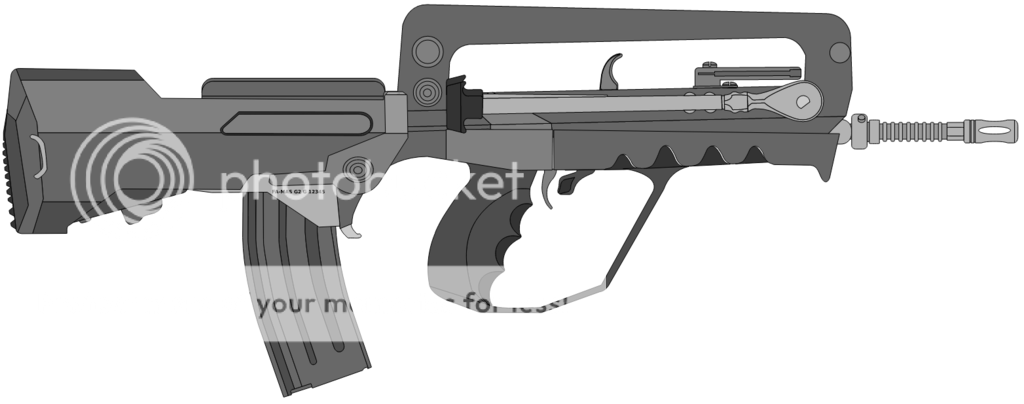
Weapon Name- F2-3A5
Round Type- 6.2mm
Over-all length- 30 inches, 24 inches
Barrel length- 21.5 inches, 15.5 inches
Weight- 6.5 lb, 6.2 lb (3.0 KG, 2.8 KG)
Rate of Fire- 600 RPM
Feed Mechanism- Detachable Box Magazine
Round Capacity- 30, 42, 100
Effective Range- 300 meters
Range- 600 meters
Accuracy- 1 MOA, 1.4 MOA
Accessories- Picatinny Rails
Quick switch firing mechanism- N/A
Scope/Sights- Picatinny Rails, Rail sight
Muzzle Velocity- 860 m/s, 6 grams, 2,218 joules
Firing System- Short-stroke gas piston
Miscellaneous/electronic information- The weapon is essentially a bullpup shortstroke gas piston based on the AR-18 firing system and chambered in the 6mm PPC.
Basic Information
The weapon is essentially a bullpup shortstroke gas piston based on the AR-18 firing system and chambered in the 6mm PPC. The weapon externally resembles the FAMAS G2, and otherwise resembles the AR-18 internally. The firearm uses a milled receiver instead of a stamped receiver, and does not possess a hole in the side of the receiver due to the bolt handle being on top of the receiver. The bolt forms a seal with the receiver to prevent dirt of other debri from getting in to the weapon's primary functioning mechanism. Short stroke gas pistons possess the same accuracy and low recoil of direct impingement systems, such as the AR-15, with much greater reliability. Instead of using an empty gas tube which directs the gases throughout the entire receiver, instead the gases are briefly stored and vented on the piston; relying more so on momentum than gas displacement, it contains the hot gases in the tip of the rifle, which keeps the weapon cooler and prevents carbon fouling from entering the rest of the receiver.
The weapon was originally designed to use the 5.56mm, but due to the lack of stopping power and the effective range, a heavier round was sought after. The 7.62mm x 39mm round was considered too heavy with too much recoil, while the 6.5mm Grendel, an ideal candidate, had even higher recoil and was considered too expensive. A somewhat cheaper alternative was chosen, utilizing the Ak case with a 6mm round, similar to the 6mm PPC. At 6 grams with 2,218 joules traveling at 860 m/s, the rounds naturally high ballistic coefficient of .408 G1 and accuracy makes it ideal for a relatively cheap and low recoil cartridge. With a case based on the 7.62mm x 39mm, it uses a smaller, 6mm bullet which reduces the recoil substantially. The round is fitted with an aluminum case, which is substantially lighter than either steel or brass cases. Approximately 3 times lighter, the aluminum allows the cartridge to possess an overall lighter weight without any considerable drawbacks; the 6mm PPC with a brass weighs approximately 14.5 grams, 6.5 grams for the case, 6 grams for the bullet, and 2 grams for the gunpowder. Using the aluminum case which is only 2.15 grams, the weapon shaves off slightly over 4 grams of weight, reducing the weight of the cartridge to about 10.5 grams, or making them about 40% lighter. Aluminum rounds were found to gall and produce excessive wear in most rifles, as well as posed a safety hazard of potentially catching on fire. This was largely mitigated through the use of an oxidation resistant coating that kept the surface of the aluminum soft, and the use of fireproof silicone based lubricants that further repelled moisture and oxygen, although accidents sometimes do occur occasionally.
The weapon differs from the AR-18 in many ways. Although the magazine superficially resembles the 5.56mm standard NATO STANAG magazines, they are actually extremely lightweight, disposable aluminum and polymer coated Ak-47 magazines, based on the magpul design. While most AR-18's use two guiding rods and recoil springs, the F2-3A5 only uses one, although it uses two springs on the same recoil rod, rather than possessing two different actions entirely. The recoil spring is more like an Ak-47 in this respect, although it possess no moving parts, neither being articulated nor spring loaded (which increases accuracy somewhat). Finally, the mechanism differs substantially in that it rides on the lower receiver of the weapon's frame, but still lifts upwards. While the bolt and bolt carrier of the weapon never touches the lower receiver of the AR-18, being completely separated, the lower receiver does come in to contact with the sliding bolt of the mechanism. Like the AR-18, the receiver folds forwards after removing two locking pins (like in the AR-15) to remove the bolt, bolt carrier and recoil spring. Unlike long stroke gas pistons, the bolt and piston are two separate pieces, which allows it to be more easily removed. While the internal mechanisms vary across models, they closely resemble the CZ. Further, the upper receiver partially encapsulates the lower receiver, rather than merely coming on contact with it, providing an additional side.

